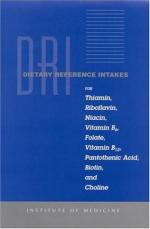|
This section contains 297 words (approx. 1 page at 300 words per page) |
A member of the vitamin B family, biotin is an important coenzyme involved in the metabolism of both carbohydrates and proteins and in the synthesis of fatty acids. It is required for cell growth and for the utilization of the other B-complex vitamins. It also may be involved in preventing hair loss. Like many vitamins, biotin was "discovered" several times--and given several different names as well.
In the l920s, for instance, various researchers isolated a growth factor for yeast that some named bios, and others called vitamin H. In 1927, biochemist M.A. Boas was the first to demonstrate a requirement for this compound in animals. Rats who were fed a diet high in raw egg whites, Boas reported, soon developed severe skin rashes, lost their fur, and became paralysed--a syndrome known as egg-white injury. (We now know that egg whites contain a protein, avidin, that--unless destroyed by heat--keeps biotin from being absorbed by the body.) But Boas found a substance in liver that he soon discovered could cure this injury--a substance he named "protective factor x."
Finally, in 1940, Vincent Du Vigneaud—an American biochemist working for a leading pharmaceutical company--realized that biotin, a relatively little known compound, was identical both to vitamin H and to "protective factor x." Intrigued by this discovery, Du Vigneaud went on to work out the coenzyme's complicated two-ring structure so that his firm's chemists could synthesize it.
Biotin is now known to be present in virtually every food, and is sometimes referred to as Vitamin B6. Moreover, the body can also synthesize it from intestinal bacteria. A biotin deficiency, therefore, is extremely rare and is seen only in infants born with a genetic disorder--and in people who, for one reason or another, eat large quantities of raw eggs.
|
This section contains 297 words (approx. 1 page at 300 words per page) |


